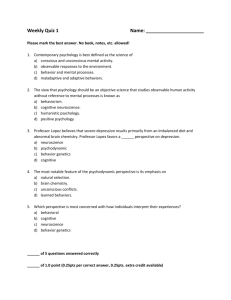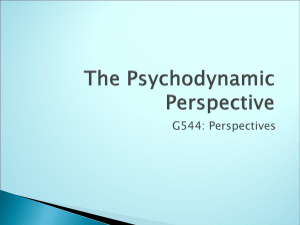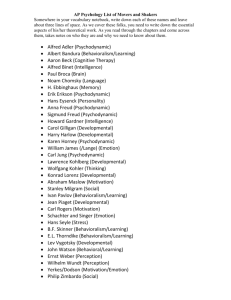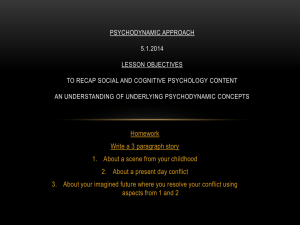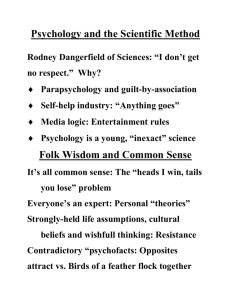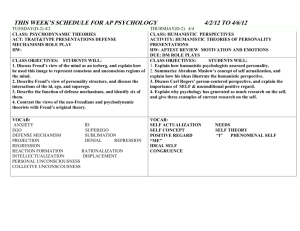Psychodynamic approach: the basics
advertisement
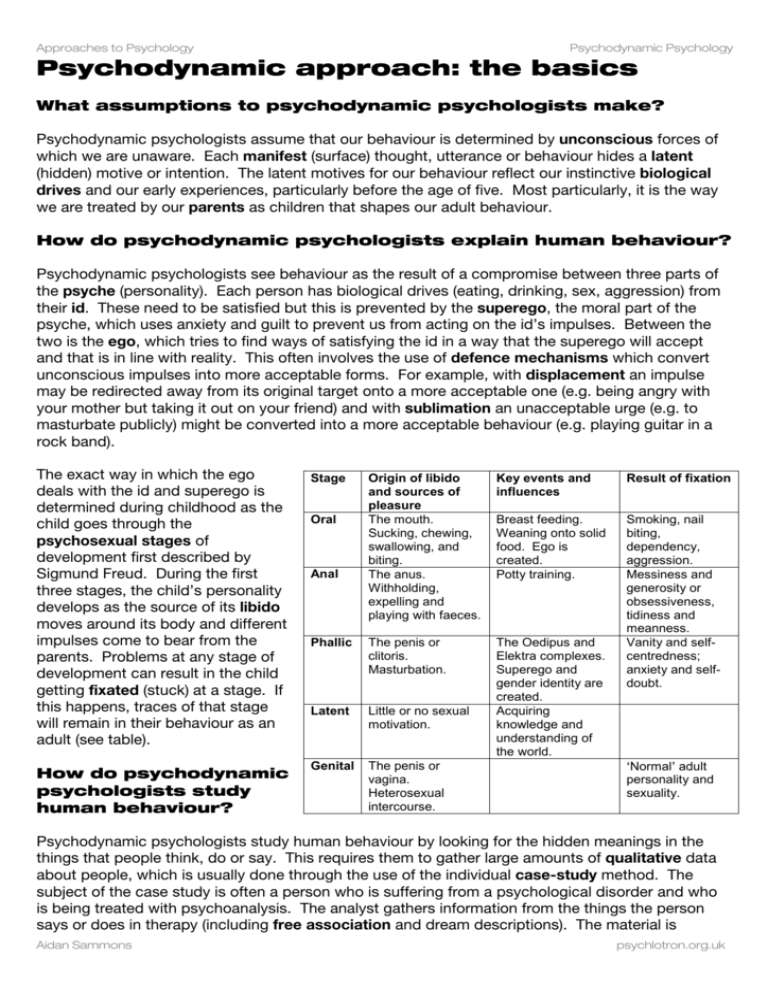
Approaches to Psychology Psychodynamic Psychology Psychodynamic approach: the basics What assumptions to psychodynamic psychologists make? Psychodynamic psychologists assume that our behaviour is determined by unconscious forces of which we are unaware. Each manifest (surface) thought, utterance or behaviour hides a latent (hidden) motive or intention. The latent motives for our behaviour reflect our instinctive biological drives and our early experiences, particularly before the age of five. Most particularly, it is the way we are treated by our parents as children that shapes our adult behaviour. How do psychodynamic psychologists explain human behaviour? Psychodynamic psychologists see behaviour as the result of a compromise between three parts of the psyche (personality). Each person has biological drives (eating, drinking, sex, aggression) from their id. These need to be satisfied but this is prevented by the superego, the moral part of the psyche, which uses anxiety and guilt to prevent us from acting on the id’s impulses. Between the two is the ego, which tries to find ways of satisfying the id in a way that the superego will accept and that is in line with reality. This often involves the use of defence mechanisms which convert unconscious impulses into more acceptable forms. For example, with displacement an impulse may be redirected away from its original target onto a more acceptable one (e.g. being angry with your mother but taking it out on your friend) and with sublimation an unacceptable urge (e.g. to masturbate publicly) might be converted into a more acceptable behaviour (e.g. playing guitar in a rock band). The exact way in which the ego deals with the id and superego is determined during childhood as the child goes through the psychosexual stages of development first described by Sigmund Freud. During the first three stages, the child’s personality develops as the source of its libido moves around its body and different impulses come to bear from the parents. Problems at any stage of development can result in the child getting fixated (stuck) at a stage. If this happens, traces of that stage will remain in their behaviour as an adult (see table). How do psychodynamic psychologists study human behaviour? Stage Origin of libido and sources of pleasure The mouth. Sucking, chewing, swallowing, and biting. The anus. Withholding, expelling and playing with faeces. Key events and influences Result of fixation Breast feeding. Weaning onto solid food. Ego is created. Potty training. Phallic The penis or clitoris. Masturbation. Latent Little or no sexual motivation. The Oedipus and Elektra complexes. Superego and gender identity are created. Acquiring knowledge and understanding of the world. Smoking, nail biting, dependency, aggression. Messiness and generosity or obsessiveness, tidiness and meanness. Vanity and selfcentredness; anxiety and selfdoubt. Genital The penis or vagina. Heterosexual intercourse. Oral Anal ‘Normal’ adult personality and sexuality. Psychodynamic psychologists study human behaviour by looking for the hidden meanings in the things that people think, do or say. This requires them to gather large amounts of qualitative data about people, which is usually done through the use of the individual case-study method. The subject of the case study is often a person who is suffering from a psychological disorder and who is being treated with psychoanalysis. The analyst gathers information from the things the person says or does in therapy (including free association and dream descriptions). The material is Aidan Sammons psychlotron.org.uk Approaches to Psychology Psychodynamic Psychology examined in order to identify repeating ideas and themes which might reflect unconscious motives and memories. The researcher must interpret the material by discovering how it is symbolic of issues in the subject’s unconscious. For example, repeated dreams about authority figures like police officers might reflect an unconscious concern with the person’s parents. Although much psychodynamic research uses patients in analysis, almost anything people do or produce is capable of being analysed in symbolic terms, so some researchers examine, for example, works of literature, paintings or even advertisements in terms of their unconscious symbolism. An example of psychodynamic research is Freud’s (1909) case study of ‘Little Hans’, who had a phobia of horses. Freud interpreted the boy’s phobia as being a displaced fear of his Father and his fear of being bitten by a horse as a manifestation of his castration anxiety. Freud identified a number of symbolic links that Hans had unconsciously made between his father and horses and used his analysis as evidence for the existence of the Oedipus complex in boys. Evaluation of the psychodynamic approach Many criticisms of the psychodynamic approach centre on its methods. The need for interpretation of the material gathered means that psychodynamic psychologists are often accused of researcher bias: they tend to favour interpretations of the data that support what they already believe. The fact that two different researchers can reach completely different interpretations suggests that the methods lack objectivity. Other critics point to the fact that the psychodynamic approach relies heavily on theoretical constructs whose existence is difficult to prove (e.g. the unconscious mind). It is claimed by some that the lack of objectivity in the methods and the dependence on unobservable constructs makes the theory impossible to test in an empirical manner, giving Freud’s approach more the status of a religion than a science. Defenders of the psychodynamic approach point to the fact that it is unique among the approaches in recognizing the complexity of human motives and the irrationality of much human behaviour. They also point out that the approach led to the development of treatments for psychological disorders (‘the talking cure’) that have helped many people live more productive and satisfying lives than they might otherwise have had. It could also be said that, even if you reject Freud’s theories, his contribution to Psychology is unarguable. Many of Freud’s insights – the importance of childhood, or the idea that we are influenced by unconscious processes, for example – remain very influential even after most of his theoretical concepts have been rejected by the mainstream. The psychodynamic approach and key debates The psychodynamic approach rejects the idea that people have free will. A person’s behaviour is determined by their unconscious motives which are shaped by their biological drives and their early experiences, making this a deterministic approach. With reference to the nature-nurture debate, the psychodynamic approach takes an interactionist position: it agrees that we are driven by innate, biological instincts (nature) but also maintains that the expression of these is heavily modified by our upbringing (nurture). The psychodynamic approach also occupies the middle ground in the debate between nomological and ideographic approaches to psychology. Whilst Freud argued that human behaviour is governed by universal processes that apply to everyone (the psyche, the psychosexual stages), reflecting a nomological understanding, psychodynamic psychologists agree that the exact ways in which these processes manifest themselves in the individual is unique in every case. Their case-study approach to research reflects this uniqueness and exemplifies an ideographic way of studying people. However, because the psychodynamic approach generally explains complex behaviours as manifestations of more primitive biological drives, it is widely regarded as a reductionist approach to psychology rather than a holistic one. Aidan Sammons psychlotron.org.uk

